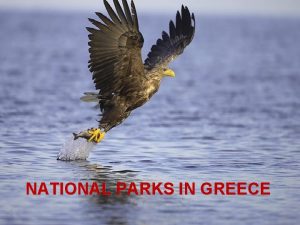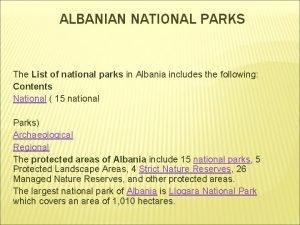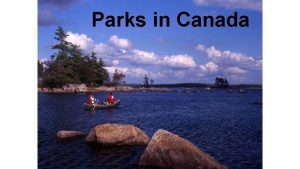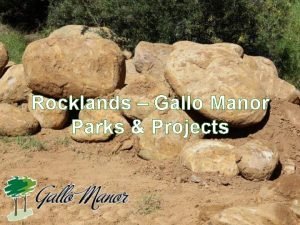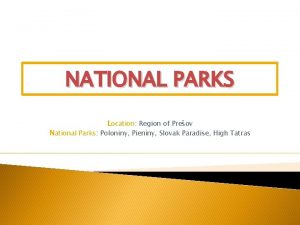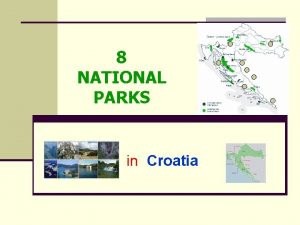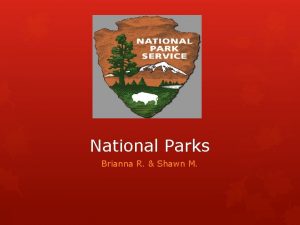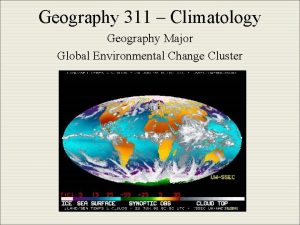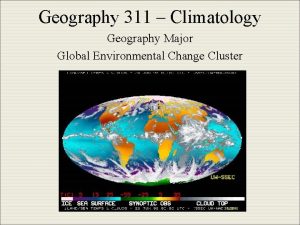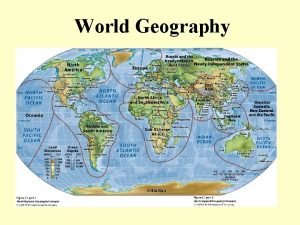Geography Presentation Americas National Parks Major National Parks



























































- Slides: 59

Geography Presentation America's National Parks

Major National Parks

The earliest action by Congress to create a large natural park took the form of a land grant of Yosemite Valley and Mariposa Big Tree Grove to the state of California in 1864. In 1890 California established these areas as a park. They were returned to the federal government in 1906 to become Yosemite National Park.

The words "national park" have special meaning to most people, conjuring up images of Old Faithful, Yosemite Falls, and the Grand Canyon.

Yellowstone National Park, in Wyoming, was the world's first national park. This is the Roosevelt Arch. President Teddy Roosevelt placed the cornerstone here.



Orangespring Mound

Castle Geyser

Old Faithful erupts, faithfully, every 91 minutes.

Yellowstone National Park is home to the Yellowstone Caldera, the largest supervolcano in North America. The caldera is considered an active volcano; it has erupted with tremendous force several times in the last two million years. Half of the world's geothermal features are in Yellowstone, fueled by this ongoing volcanism. Lava flows and rocks from volcanic eruptions cover most of the land area of Yellowstone.


Grand Prismatic Spring





Although it's one of America's most beautiful parks, Yellowstone is still prone to one particular type of natural disaster: wildfire.


Yosemite

Yosemite National Park is located in the central Sierra Nevada of California. It takes approximately 3. 5 hours to drive to the park from San Francisco, and approximately 6 hours from Los Angeles. The 1, 189 sq mi park is roughly the size of Rhode Island contains thousands of lakes and ponds, 1, 600 miles of streams, 800 miles of hiking trails, and 350 miles of roads. Two federally designated Wild and Scenic Rivers, the Merced and the Tuolumne, begin within Yosemite's borders and flow westward through the Sierra foothills, into the Central Valley of California. Annual park visitation exceeds 3. 5 million, with most visitor use concentrated in the seven square mile area of Yosemite Valley. Yosemite is internationally recognized for its spectacular granite cliffs, waterfalls, clear streams, Giant Sequoia groves, and biological diversity. Almost 95% of the park is designated wilderness.


Merced River

Half Dome

El Capitan

Bridal Vail Falls

Mule Deer Buck

Black Bear

Yosemite Marmot

President Theodore Roosevelt and naturalist John Muir overlooking Yosemite's Bridal Vail Falls.

Grand Canyon National Park is one of the United States' oldest national parks and is located in Arizona. Within the park lies the Grand Canyon, a gorge of the Colorado River, considered to be one of the major natural wonders of the world. The park covers 1, 902 mi².

Grand Canyon from space


The Skywalk





Grand Canyon Post Office, located on the floor of the canyon.





Banff National Park, Canada

Banff National Park is located In Canada, on Alberta's western border with British Columbia. Banff is about an hour and half driving distance from Calgary, and four hours from Edmonton. Banff National Park is Canada's oldest national park, established in 1885 in the Rocky Mountains. The park encompasses 2, 564 sq mi of mountainous terrain, with numerous glaciers and ice fields, dense coniferous forest, and alpine landscapes.


Badlands National Park is located in South Dakota, just miles from Mount Rushmore National Monument.



Arches National Park

Arches National Park is a U. S. national park in eastern Utah. It is known for preserving over 2000 natural sandstone arches, including the world-famous Delicate Arch, in addition to a variety of unique geological resources and formations. The park is located near Moab, Utah, and is 119 square miles in size. Its highest elevation is 5, 653 feet at Elephant Butte, and its lowest elevation is 4, 085 feet at the visitor center. Since 1970, forty-three arches have toppled because of erosion. The park receives 10 inches of rain a year on average.

Bryce Canyon National Park is a national park located in southwestern Utah in the United States. Contained within the park is Bryce Canyon. Despite its name, this is not actually a canyon, but rather a giant natural amphitheater created by erosion along the eastern side of the Paunsaugunt Plateau.

Thunderstorm over Great Smoky Mountains National Park. The Smokies are the wettest spot in the lower-48 except for the Pacific Northwest, with the high elevations scraping rain out of the sky to water the wonderful forest.

Bridge, Great Smoky Mountains National Park. The abundant rainfall in the Smokies feeds numerous beautiful streams, such as seen here and in the next picture; many streams host native brook trout.

This photo and the next, from the USGS archives, were taken by W. B. Hamilton in 1954. They show two of the many beautiful waterfalls in the Smokies. A little extra description of waterfalls is inserted between the two.

Waterfalls usually indicate something interesting in recent geological time; water flows faster and erodes more on steeper slopes, so waterfalls quickly become rapids. Hence, these waterfalls suggest a recent event, perhaps of mountain-building. Yet, the newest scientific studies suggest that conditions have not changed recently. The debate is more than academic; if mountainbuilding has occurred recently, then the risk of earthquakes is higher than it otherwise would be, with implications for zoning codes and construction practices and emergency services. Although the basic outline of geology is well-known, large and important questions remain!

Another Smoky Mountain waterfall photo from the USGS archives, taken by W. B. Hamilton in 1954.

Late-autumn view, Great Smoky Mountains National Park. The ridges fading into the distance are typical of the Appalachians.

Metamorphic rocks near Cades Cove, Great Smoky Mountains National Park. Heating caused former muds to change into new minerals, and squeezing caused the prominent folds seen. A rich and varied geological history is recorded in the diverse and beautiful rocks of the Smokies. USGS photo by W. B.
 State parks nevada map
State parks nevada map National parks in greece
National parks in greece Albanian national parks
Albanian national parks Spanish caste system in the americas
Spanish caste system in the americas Spanish colonization of the americas
Spanish colonization of the americas Soroptimist international of the americas
Soroptimist international of the americas Art of the americas before 1300
Art of the americas before 1300 Ib history of the americas study guide
Ib history of the americas study guide European colonization of americas
European colonization of americas Declaración sobre seguridad en las américas 2003
Declaración sobre seguridad en las américas 2003 Spanish caste system in the americas
Spanish caste system in the americas Americas guardians mc
Americas guardians mc Centro de convenciones las americas
Centro de convenciones las americas The beginnings of our global age europe and the americas
The beginnings of our global age europe and the americas Transversal de las americas
Transversal de las americas Openedge multi-tenant database
Openedge multi-tenant database Chapter 24 the americas and oceania
Chapter 24 the americas and oceania Chapter 24 new worlds the americas and oceania
Chapter 24 new worlds the americas and oceania Chapter 24 new worlds the americas and oceania
Chapter 24 new worlds the americas and oceania Chapter 20 worlds apart the americas and oceania
Chapter 20 worlds apart the americas and oceania The beginnings of our global age europe and the americas
The beginnings of our global age europe and the americas Chapter 10 global cuisine 1 the americas
Chapter 10 global cuisine 1 the americas Open door policy cartoons
Open door policy cartoons Universidad peruana de las americas
Universidad peruana de las americas The americas on the eve of invasion
The americas on the eve of invasion State building in the americas and africa
State building in the americas and africa Americas global position
Americas global position Chapter 2 exploring the americas study guide
Chapter 2 exploring the americas study guide Chapter 2 exploring the americas
Chapter 2 exploring the americas Asociación de supervisores bancarios de las américas
Asociación de supervisores bancarios de las américas Rochem
Rochem Network reliability and security
Network reliability and security Chapter 16 people and empires in the americas
Chapter 16 people and empires in the americas Boxer rebellion lesson plan
Boxer rebellion lesson plan The americas in the age of independence
The americas in the age of independence International gateway of the americas
International gateway of the americas Corporate risk minds
Corporate risk minds Dkms americas
Dkms americas Cómo se enseña
Cómo se enseña Vsnl americas
Vsnl americas Hte americas
Hte americas Doric columns in america
Doric columns in america Geonetcast americas
Geonetcast americas Aemet las americas
Aemet las americas Dkms americas
Dkms americas Hte americas
Hte americas Americas game
Americas game Geography major
Geography major Ap human geography political geography frq
Ap human geography political geography frq 5 themes of geography ap human geography
5 themes of geography ap human geography Ap human geography political geography test
Ap human geography political geography test Geography poster presentation
Geography poster presentation Pedestrian count data presentation
Pedestrian count data presentation Fetal lie
Fetal lie Leopold maneuver
Leopold maneuver National geography standards
National geography standards Centrality ap human geography
Centrality ap human geography National geography
National geography Wakulla rec park soccer
Wakulla rec park soccer Park model hazards
Park model hazards

